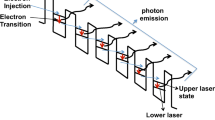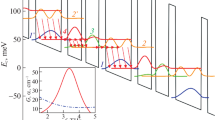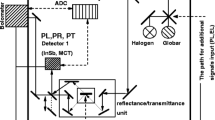We study the band designs of terahertz quantum–cascade lasers (THz QCLs) with an active region of GaAs/AlxGa1−xAs quantum wells (QWs) by using the solution of the Schrödinger equation with allowance for dephasing of quantum states, as well as solving a system of closed balance equations. For two-QW designs with increased AlxGa1−xAs potential barrier height (x = 0.20, 0.25, and 0.30), temperature dependences of the peak gain are calculated. It is shown that by increasing the aluminum content in the barrier layers compared to the conventional x = 0.15, it becomes possible to increase the operating temperatures of THz QCLs by more than 220 K. Two new designs of laser transitions are proposed to increase the output power and operating temperature of THz QCLs. To increase the output power, a design with a two-photon scheme of laser transitions was proposed, which causes an approximately twofold slower drop in the nonlinear gain with increasing photon density. To increase operating temperatures, it is suggested to use weakly localized electron states with wave functions extending over two or more periods of the structure. The matrix element of dipole transitions in such structures is shown to be greatly increased, while the lower laser level has a larger energy gap with the injector, is less populated, and is more temperature stable compared to the conventional designs. In this case, the calculated value of the maximum operating temperature is about 250 K.
Similar content being viewed by others
References
R.Kohler, A.Tredicucci, F.Beltram, et al., Nature, 417, 156–159 (2002). https://doi.org/10.1038/417156a
A. Khalatpour, A. K. Paulsen, C. Deimert, et al., Nat. Photon., 15, 16–20 (2021). https://doi.org/10.1038/s41566-020-00707-5
B.Wen and D. Ban, Prog. Quantum Electron., 80, 100363 (2021). https://doi.org/10.1016/j.pquantelec.2021.100363
Y. J. Han, L. H. Li, J. Zhu, et al., Opt. Express., 26, No. 4, 3814–3827 (2018). https://doi.org/10.1364/OE.26.003814
D. V. Ushakov, A. A. Afonenko, A.A.Dubinov, et al., Quantum Electron., 48, 1005–1005 (2018). https://doi.org/10.1070/QEL16806
L. Consolino, M. Nafa, M.De Regis, et al., Commun. Phys., 3, No. 1, 69 (2020). https://doi.org/10.1038/s42005-020-0344-0
Y. Irimajiri, I. Morohashi, and A.Kawakami, IEEE Trans. Terahertz Sci. Technol., 10, No. 5, 474–479 (2020). https://doi.org/10.1109/TTHZ.2020.2990358
A. D.Raki´c, T.Taimre, K. Bertling, et al., Appl. Phys. Revs., 6, 021320 (2019). https://doi.org/10.1063/1.5094674
R. A. Khabibullin, N.V. Shchavruk, A.N.Klochkov, et al., Semiconductors, 51, No. 4, 514–519 (2017). https://doi.org/10.1134/S106378261704008X
L. Bosco, M. Francki´e, G. Scalari, et al., Appl. Phys. Lett., 115, 010601 (2019). https://doi.org/10.1063/1.5110305
R. A. Khabibullin, N.V. Shchavruk, A.Yu.Pavlov, et al., Semiconductors, 50, No. 10, 1377–1382 (2016). https://doi.org/10.1134/S1063782616100134
A.V. Ikonnikov, K.V. Marem’yanin, S.V. Morozov, et al., Tech. Phys. Lett., 43, 362–365 (2017). https://doi.org/10.1134/S1063785017040083
R. A. Khabibullin, N.V. Shchavruk, D. S.Ponomaryov, et al., Semiconductors, 52, No. 11, 1380–1385 (2018). https://doi.org/10.1134/S1063782618110118
G.E.Tsyrlin, R.R.Reznik, A. E. Zhukov, et al., Semiconductors, 54, No. 9, 1092–1095 (2020). https://doi.org/10.1134/S1063782620090298
R. A. Khabibullin, K.V.Marem’yanin, D. S.Ponomaryov, et al., Semiconductors, 56, No. 2, 71–77 (2022). https://doi.org/10.1134/S1063782622010080
T. A. Bagaev, M. A. Ladugin, A.A.Marmalyuk, et al., Tech. Phys. Lett., 48, No. 5, 45–47 (2022). https://doi.org/10.21883/TPL.2022.05.53479.19162
D. V. Ushakov, A. A. Afonenko, A.A.Dubinov, et al., Quantum Electron., 49, No. 10, 913–918 (2019). https://doi.org/10.1070/QEL17068
D. Ushakov, A. Afonenko, R.Khabibullin, et al., Opt. Express, 28, No. 17, 25371–25382 (2020). https://doi.org/10.1364/OE.398552
C. Sirtori, P.Kruck, S.Barbieri, et al., Appl. Phys. Lett., 73, No. 24, 3486–3488 (1998). https://doi.org/10.1109/QELS.1999.807074
I.Vurgaftman, J.R.Meyer, and L.R.Ram-Mohan, J. Appl. Phys., 89, No. 11, 5815–5875 (2001). https://doi.org/10.1063/1.1368156
M. Franckié, D.O.Winge, J.Wolf, et al., Opt. Express, 23, N. 4, 5201–5212 (2015). https://doi.org/10.1364/OE.23.005201
D.V.Ushakov and I. S. Manak, J. Applied Spectroscopy, 74, No. 6, 892–896 (2007). https://doi.org/10.1007/s10812-007-0138-0
V. B. Gorfinkel, S. Luryi, and B. Gelmont, IEEE J. Quantum Electron., 32, No. 11, 1995–2003 (1996). https://doi.org/10.1109/3.541687
R. Khabibullin, D.Ushakov, A.Afonenko, et al., Proc. SPIE, 11066, 1106613. https://doi.org/10.1117/12.2523284
R. Khabibullin, D.Ushakov, A.Afonenko, et al., Proc. SPIE, 11022, 1102204. https://doi.org/10.1117/12.2521774
B.Wen, C. Xu, S.Wang, et al., Opt. Express, 26, No. 7, 9194–9204 (2018). https://doi.org/10.1364/OE.26.009194
A. N. Baranov, H. Nguyen-Van, Z. Loghmari, et al., AIP Advances, 9, 055214 (2019). https://doi.org/10.1063/1.5092855
Author information
Authors and Affiliations
Corresponding author
Additional information
Translated from Izvestiya Vysshikh Uchebnykh Zavedenii, Radiofizika, Vol. 65, Nos. 5–6, pp. 505–515, May–June 2022. Russian DOI: https://doi.org/10.52452/00213462_2022_65_05_505
Rights and permissions
Springer Nature or its licensor (e.g. a society or other partner) holds exclusive rights to this article under a publishing agreement with the author(s) or other rightsholder(s); author self-archiving of the accepted manuscript version of this article is solely governed by the terms of such publishing agreement and applicable law.
About this article
Cite this article
Ushakov, D.V., Afonenko, A.A., Ponomarev, D.S. et al. New Designs of Laser Transitions in Terahertz Quantum–Cascade Lasers. Radiophys Quantum El 65, 461–470 (2022). https://doi.org/10.1007/s11141-023-10228-0
Received:
Accepted:
Published:
Issue Date:
DOI: https://doi.org/10.1007/s11141-023-10228-0




